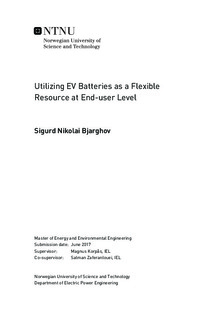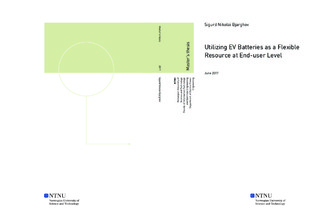| dc.description.abstract | As part of the agreement 195 countries signed in order to lower GHG emis-
sions and reduce global warming, Norway has through the Paris Climate
Agreement agreed to lower GHG emissions significantly in the future. While
other countries are mainly reducing their emissions in the power production
sector, Norway s electricity production is accountable for only 3 % of the
national GHG emissions, due to a high share of hydro power. Respons-
ible for 19 % of national GHG emissions, the road transport sector is a
more efficient sector to cut CO2-emissions. Through extensive subsidies of
electric vehicles (EVs) and photovoltaic (PV) panels, the goal is to have a
carbon neutral state by 2050.
With more than 300 GW installed PV power worldwide by the end of 2016, Norway is barely taking part in the solar revolution, being only accountable for 27 MW installed capacity, with 11 MW being installed in2016. In comparison, worldwide installed capacity in 2016 was 75 GW. PV is experiencing this massive growth due to sinking costs, increased energy demand and more climate oriented policies. Meanwhile, because battery costs together with PV costs, have been dropping massively in the last decade, the question of profitability for such distributed energy systems has reached Norway, in spite of low energy prices, semi-low solar irradiation and high investment costs.
Due to massive subsidies, Norway reached 100 000 EVs in 2016. Although reducing national GHG emissions, an increased share of EVs could lead to problems in the distribution grid due to high power demand during charging. Meanwhile, an average vehicle is parked 95 % of the time, which results in a huge amount of high power high energy batteries being connected to the grid at all times. These are batteries that in theory could be utilized for load balancing.
With increased amount of unpredictable renewable energy production, new
challenges arise. Increased distributed energy production leads to bidirec-
tional power flow in the distribution grid, and can result in certain problems
related to overloading and voltage deviations.
In order to face the challenges that come with increased distributed energy production in the shape of PV, the implementation of smart meters (AMS) will take place in every Norwegian residence before the beginning of 2019. With AMS, distribution grid operators can reshape their grid tariff structures, creating price incentives to control load in order to utilize the gridmore efficiently. AMS also opens the possibility to use smart control to buy cheap energy from the spot price market for storage, in order to either sell or consume when the prices are higher. In order to promote efficient grid use, NVE is developing new grid tariff structures that assures economic advantage for those who take advantage of these (8). Four new grid tariffs have been utilized in this thesis; energy based, power based, time based and subscription based.
By modelling a battery, PV and residence load by using load and irradi-
ation data, a household is simulated throughout one year. Utilizing dynamic
programming, an optimization algorithm is developed in order to find the
optimal operation of the battery that ensures minimal cost for the customer,
given that load, spot price, grid tariffs and PV production is known (de-
terministic model). At the same time, new grid tariffs are formed to see
how new price structures can lead to more efficient use of the grid, espe-
cially through optimized use of distributed energy production and storage
such as PV and battery utilization. The optimization is performed with
both a stationary house battery, and an EV battery, in order to compare
how an EV battery can potentially replace a house battery.
Results show that PV as of 2017 in Norway is not profitable, but that it
with lower investment costs and higher energy prices can be profitable in
the future. In addition, EV batteries increases the savings by working as
a balancing element, utilizing variations in the spot price and grid tariffs
to provide 12.0 - 19.2 % savings in symbiosis with PV (depending on grid
tariff structure), compared to the 8.9 - 14.4 % when using a house battery
with PV (depending on grid tariff structure).
While only the subscription based tariff did the peak load go down annually,
while the remaining tariffs either increased or kept the existing peak load
of the household. The higher peak loads did not interfere with classic peak
load hours on a national basis. To conclude, the new grid tariffs resulted
in more efficient use of the grid while at the same time having potential for
improvement. | |

